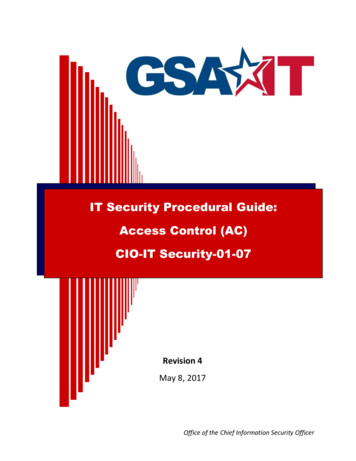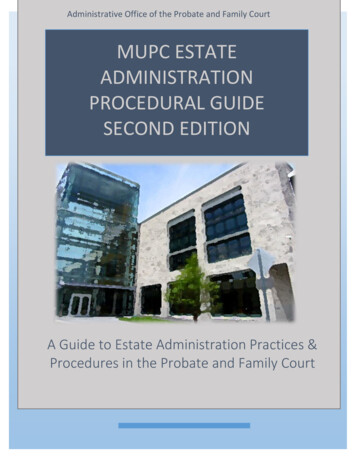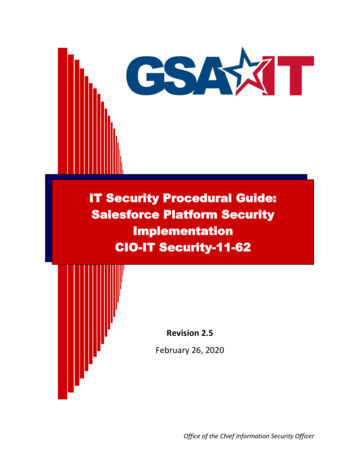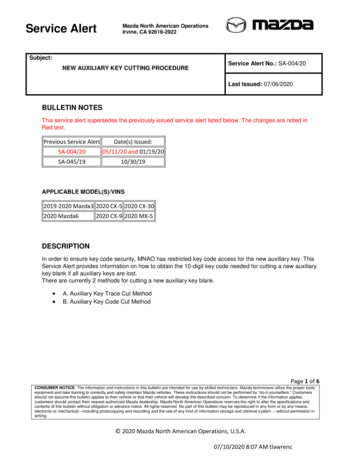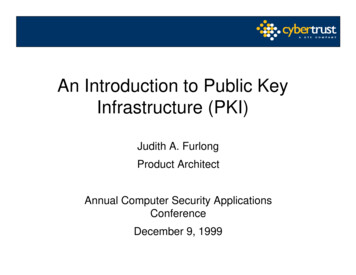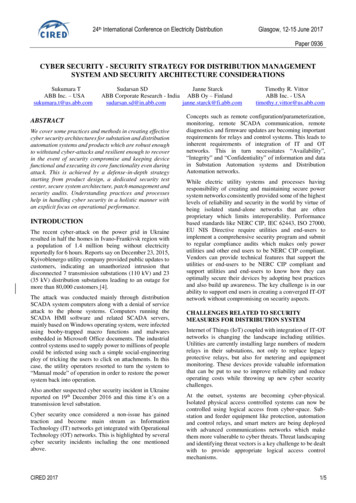
Transcription
IT Security Procedural Guide:Key ManagementCIO-IT Security-09-43Revision 4April 13, 2020Office of the Chief Information Security Officer
CIO-IT Security-09-43, Revision 4Key ManagementVERSION HISTORY/CHANGE mmelRevision 1 – November 19, 2008Additional References to x.509Common Framework1SalamonRevision 2 – February 25, 2016Updated Policy and NIST references2Wilson,KlemensUpdated GSA Logo, formatting,style monRevision 3 – March 6, 2018Removed NIST SP 800-21 andupdated Policy referencesUpdated Procedural Guide linksChanges throughout the documentto correspond with current guidestructure and formatting.Revision 4 – April 13, 2020Updated references and minorlanguage clarificationsReason for ChangePageNumber ofChangeResponse to comments1,6,16Updated to current versions ofCIO 2100.1, NIST SP 800-53, andNIST SP 800-57ThroughoutUpdated GSA Logo, formattingand style.ThroughoutNIST SP 800-21 withdrawn,updated to current CIO 2100.1Updated Procedural GuidesUpdated to current guidestructure, style, and formatting2, 7, 178ThroughoutScheduled updateThroughoutUpdated Section 2 to includespecific requirements for keymanagementOperational feedback7Scope updated in Section 1.2Operational feedback3U.S. General Services Administration
CIO-IT Security-09-43, Revision 4Key ManagementApprovalIT Security Procedural Guide: Key Management, CIO-IT Security-09-43, Revision 4 is herebyapproved for distribution.XBo BerlasChief Information Security OfficerContact: GSA Office of the Chief Information Security Officer (OCISO), Security EngineeringDivision (ISE) at SecEng@gsa.govU.S. General Services Administration
CIO-IT Security-09-43, Revision 4Key ManagementTable of Contents1Introduction . 11.1Purpose . 21.2Scope . 31.3Policy . 31.3.1 GSA IT Security Policy, CIO 2100.1 . 31.3.2 NIST SP 800-53, Security and Privacy Controls for Federal Information Systems andOrganizations . 41.3.3 FIPS 140-2, Security Requirements for Cryptographic Modules . 61.4References . 72Procedures. 82.12.23GSA Requirements for Key Usage . 8Documenting Key Management Systems . 8Summary . 11Appendix A – Glossary and Acronyms . 12U.S. General Services Administrationi
CIO-IT Security-09-43, Revision 41Key ManagementIntroductionEncryption is an important tool used to meet security control requirements in the FederalInformation Security Modernization Act (FISMA) of 2014, National Institute of Standards andTechnology (NIST) Special Publication (SP) 800-53 Revision 4, “Security and Privacy Controls forFederal Information Systems and Organizations”, and the General Services Administration (GSA)Order CIO 2100.1, “GSA Information Technology (IT) Security Policy”. When used to protectsensitive information, Federal systems must use encryption that meets the requirements of theFederal Information Processing Standards (FIPS) 140-2, “Security Requirements forCryptographic Modules.” Once a system has been designed and deployed using FIPS complianttechnologies it must be operated following documented procedures to ensure keys are created,stored, retired, revoked and otherwise managed in a consistent and secure manner.The NIST promulgated FIPS 140-2 to ensure that encryption technology meets minimumstandards when protecting sensitive data on Federal networks and systems. All cryptographicmodules used in Federal systems must meet the standards in FIPS 140-2. FIPS 140-2 provides acertification path for vendors of cryptographic modules. Certification ensures that thestandards are met in the specific vendor implementation. FIPS does not specify procedures andprocesses for management of these systems. General guidance is provided in NIST SP 800-57,“Recommendation for Key Management”, Part 1, Part 2, and Part 3. Appendix A contains aglossary to clarify terms used throughout this guide.Encryption is used in IT systems to meet several security requirements. These includeconfidentiality of information in storage or in transit, integrity of files, authentication of peopleand systems, signatures to establish the pedigree of information, and many other applications.Encryption is often used as a small component of a larger application. There are various typesof encryption. This guide focuses upon encryption that uses keys. Encryption algorithms andtheir associated keys are either symmetric or asymmetric. In symmetric key cryptography, thesame key is used for both encryption and decryption. In asymmetric key cryptography, pairs ofkeys are used together; one to encrypt and the other to decrypt the content. Symmetric keysare faster and more suited to bulk encryption. Asymmetric keys are slower but are thefoundation for public, private key systems including public key infrastructure (PKI). In bothtypes of cryptography, access to keys must be carefully controlled. The confidentiality andintegrity of key material is at least as important as the confidentiality and integrity of the datathat it protects.PKI systems should comply with the Federal Public Key Infrastructure Policy Authority (FPKIPA)X.509 Version 1.31, “Certificate Policy For The U.S. Federal PKI Common Policy Framework”standards for the creation, distribution and management of signed digital certificates. Thesecertificates incorporate public keys and other information to ensure the authenticity of thedigital signature and the contents of the certificate.To prevent misuse or exploitation, keys should expire after a carefully chosen period of time.The time from creation to expiration is called the “cryptoperiod” of the key. Although the keyU.S. General Services Administration1
CIO-IT Security-09-43, Revision 4Key Managementmay be revoked before its expiration, the cryptoperiod is the longest that a key should remainvalid.In some applications, keys are generated frequently and used for a very short duration. In othercases, the keys are “persistent”. Persistent keys are usually “bound” to a process, device,person or data set, and are used for an extended period. Persistent keys may be used toauthenticate, encrypt data for extended periods, distribute other keys, and/or provide digitalsignatures. With the exception of bulk data encryption, most persistent keys are asymmetricwhere one key is designated as a generally available public key and the other is a carefullyguarded private key.Although all keys must be managed securely, persistent keys are of particular importance. Thisis because persistent keys exist over an extended period of time during which different peoplemay manage them.There are many ways of assigning roles and responsibilities for Key Management. FIPS 140-2suggests, at minimum, a framework that includes a user role, a crypto-officer role, and amaintenance role. A separate audit role may also be appropriate.1.1 PurposeThis guide will provide a framework to document operating procedures and processes that arerequired by GSA IT Security Policies, FISMA and FIPS 140-21. These policies set generalstandards that must be adhered to. Other documents such as NIST 800-57 provide detailedrecommendations for creating these procedures and processes. The Key Management guiderecommends a consistent documentation framework that will help each project meet the policyrequirements. The details of processes vary from system to system; however, basic roles,responsibilities, and task categories are common enough to benefit from standardizeddocumentation. The purpose of this guide is to introduce a template for documenting thefollowing set of common Key Management tasks: Setting Roles and ResponsibilitiesCreating KeysManaging the Storage of KeysDistribution of KeysChanging KeysArchiving KeysDestruction of Keys1Please note that while FIPS 140-3 has been released, implementing guidance is still in progress and FIPS 140-2certificates will continue to be issued.U.S. General Services Administration2
CIO-IT Security-09-43, Revision 4Key ManagementFor information on designing or improving the procedures used in Key Management systems,see NIST SP 800-57, Part 2.1.2 ScopeThis guide is applicable to all systems that create, manage, and revoke persistent keys used toprotect sensitive information. For the purpose of this guide, “persistent” keys have acryptoperiod of more than three (3) months, and “sensitive” information includes the following: Personally Identifiable Information (PII) as defined by GSA policySensitive financial data including Payment Card Industry (PCI) dataData categorized as Controlled Unclassified Information (CUI), Sensitive ButUnclassified (SBU), or For Official Use Only (FOUO)Authenticator dataAny other information designated as sensitive by the data owner, GSA policy orfederal regulation.This guide is NOT applicable to systems that manage only the following: Keys that are created and managed automatically by software without operatorintervention;Keys that are not a part of GSA systems;Keys that are not “persistent”;Keys that are not used in the storage, transfer or authentication of “sensitive”information;Keys that are used in classified systems.Keys used for authenticating devices for actions that are low impact as defined inSection 3.2 of NIST SP 800-60 Volume 1, “Guide for Mapping Types of Informationand Information Systems to Security Categories.”1.3 PolicySelected governing policy statements from NIST/FIPS and GSA CIO 2100.1 applicable to KeyManagement procedures are listed in the following sections.1.3.1 GSA IT Security Policy, CIO 2100.1CIO Order 2100.1 Chapter 4, Policy for Protect Function, states the following:Paragraph 3, Data securitya. All PII and PCI data, and business sensitive data as determined by the AO, andauthenticators, including but not limited to passwords, keys, and tokens must beencrypted in storage.U.S. General Services Administration3
CIO-IT Security-09-43, Revision 4Key Managementc. All agency data on portable storage devices (e.g., USB flash drives, SD cards, externalhard drives), must be encrypted with a FIPS 140-2 certified encryption module.d. If it is a business requirement to store PII on GSA user workstations or mobile devicesincluding, but not limited to notebook computers, USB drives, CD-ROMs/DVDs, personaldigital assistants, PII must be encrypted using a FIPS 140-2 certified encryption module.g. All sensitive information, such as PII, as deemed by the data owner, which istransmitted outside the GSA firewall, must be encrypted. Certified encryption modulesmust be used IAW FIPS 140-2, Security requirements for Cryptographic Modules.h. An employee or contractor shall not physically take out PII from GSA facilities(including GSA managed programs housed at contractor facilities under contract), oraccess remotely (i.e., from locations other than GSA facilities), without writtenpermission from the employee’s supervisor, the data owner, and the IT system AO.Approvals shall be filed with the employee’s supervisor. This applies to electronic media(e.g., laptops, USB drives), paper, and any other media (e.g., CDs/DVDs) that maycontain PII.q. When using password generated encryption keys, a password of at least 8 characterswith a combination of letters, numbers, and special characters is required.r. Systems implementing encryption must follow the Key Management procedures andprocesses documented in GSA CIO-IT Security-09-43: Key Management.Paragraph 6, Protective technologye. Protect digital media during transport outside of controlled areas using a certified FIPS140-2 encryption module; non-digital media shall follow GSA personnel securityprocedures.1.3.2 NIST SP 800-53, Security and Privacy Controls for Federal Information Systems andOrganizationsControl SC-12: Cryptographic Key Establishment and ManagementControl: The organization establishes and manages cryptographic keys for requiredcryptography employed within the information system in accordance with NIST and FIPSrequirements for key generation, distribution, storage, access, and destruction.Supplemental Guidance: Cryptographic Key Management and establishment can beperformed using manual procedures or automated mechanisms with supporting manualprocedures. Organizations define Key Management requirements in accordance withapplicable federal laws, Executive Orders, directives, regulations, policies, standards, andguidance, specifying appropriate options, levels, and parameters. Organizations managetrust stores to ensure that only approved trust anchors are in such trust stores. ThisU.S. General Services Administration4
CIO-IT Security-09-43, Revision 4Key Managementincludes certificates with visibility external to organizational information systems andcertificates related to the internal operations of systems. Related controls: SC-13, SC-17.Control Enhancements: For high impact systems,(1) Cryptographic Key Establishment and Management AvailabilityThe organization maintains availability of information in the event of the loss ofcryptographic keys by users.Supplemental Guidance: Escrowing of encryption keys is a common practice forensuring availability in the event of loss of keys (e.g., due to forgotten passphrase).Control SC-13: Cryptographic ProtectionControl: The information system implements FIPS-validated or NSA-approved cryptographyin accordance with applicable federal laws, Executive Orders, directives, policies,regulations, and standards.Supplemental Guidance: Cryptography can be employed to support a variety of securitysolutions including, for example, the protection of classified and Controlled UnclassifiedInformation, the provision of digital signatures, and the enforcement of informationseparation when authorized individuals have the necessary clearances for such informationbut lack the necessary formal access approvals. Cryptography can also be used to supportrandom number generation and hash generation. Generally applicable cryptographicstandards include FIPS-validated cryptography and NSA-approved cryptography. Thiscontrol does not impose any requirements on organizations to use cryptography. However,if cryptography is required based on the selection of other security controls, organizationsdefine each type of cryptographic use and the type of cryptography required (e.g.,protection of classified information: NSA-approved cryptography; provision of digitalsignatures: FIPS-validated cryptography). Related controls: AC-2, AC-3, AC-7, AC-17, AC-18,AU-9, AU-10, CM-11, CP-9, IA-3, IA-7, MA-4, MP-2, MP-4, MP-5, SA-4, SC-8, SC-12, SC-28,SI-7.Control SC-28 (1): Protection of Information at Rest Cryptographic ProtectionControl: The information system implements cryptographic mechanisms to preventunauthorized disclosure and modification of (1) Personally identifiable information; (2)Payment Card Industry data; (3) Authenticators, including but not limited to passwords,keys, and tokens; (4) business sensitive data as determined by the data owner andapproved by the AO on any system component, including databases (i.e., table, column, orfield level) or applications.Supplemental Guidance: Selection of cryptographic mechanisms is based on the need toprotect the confidentiality and integrity of organizational information. The strength ofmechanism is commensurate with the security category and/or classification of theU.S. General Services Administration5
CIO-IT Security-09-43, Revision 4Key Managementinformation. This control enhancement applies to significant concentrations of digitalmedia in organizational areas designated for media storage and also to limited quantitiesof media generally associated with information system components in operationalenvironments (e.g., portable storage devices, mobile devices). Organizations have theflexibility to either encrypt all information on storage devices (i.e., full disk encryption) orencrypt specific data structures (e.g., files, records, or fields). Organizations employingcryptographic mechanisms to protect information at rest also consider cryptographic keymanagement solutions. Related controls: AC-19, SC-12.1.3.3 FIPS 140-2, Security Requirements for Cryptographic ModulesSection 1.1, Security Level 12,Security Level 1 provides the lowest level of security. Basic security requirements arespecified for a cryptographic module (e.g., at least one Approved algorithm or Approvedsecurity function shall be used). No specific physical security mechanisms are required in aSecurity Level 1 cryptographic module beyond the basic requirement for production-gradecomponents. An example of a Security Level 1 cryptographic module is a personalcomputer (PC) encryption board.Security Level 1 allows the software and firmware components of a cryptographic moduleto be executed on a general purpose computing system using an unevaluated operatingsystem. Such implementations may be appropriate for some low-level security applicationswhen other controls, such as physical security, network security, and administrativeprocedures are limited or nonexistent. The implementation of cryptographic software maybe more cost-effective than corresponding hardware-based mechanisms, enablingorganizations to select from alternative cryptographic solutions to meet lower-levelsecurity requirements.Security Requirements(Security Level 1):CryptographicModule SpecificationRoles, Services, on of cryptographic module, cryptographic boundary,Approved algorithms, and Approved modes of operation.Description of cryptographic module, including all hardware,software, and firmware components. Statement of module securitypolicy.Logical separation of requiredLogical separationand optionalof rolesrequiredand services.and optionalroles and services.Single operator. Executable code. Approved integrity technique.2Note that since GSA does not require cryptography higher than Security Level 1 for any of its applications, onlySecurity Level 1 requirements are itemized here.U.S. General Services Administration6
CIO-IT Security-09-43, Revision 4Security Requirements(Security Level 1):EnvironmentCryptographic KeyManagementKey ManagementDescriptionKey Management mechanisms: random number and keygeneration, key establishment, key distribution, key entry/output,key storage, and key zeroization.Secret and private keys established using manual methods may beentered or output in plaintext form.Section 4.3: Roles, Services, and AuthenticationA cryptographic module shall support authorized roles for operators and correspondingservices within each role. Multiple roles may be assumed by a single operator. If acryptographic module supports concurrent operators, then the module shall internallymaintain the separation of the roles assumed by each operator and the correspondingservices. An operator is not required to assume an authorized role to perform serviceswhere cryptographic keys and CSPs are not modified, disclosed, or substituted (e.g., showstatus, self-tests, or other services that do not affect the security of the module).Authentication mechanisms may be required within a cryptographic module to authenticatean operator accessing the module, and to verify that the operator is authorized to assumethe requested role and perform the services within the role.Section 4.3.3: Operator AuthenticationDocumentation shall specify: the authentication mechanisms supported by a cryptographic module,the types of authentication data required by the module to implement thesupported authentication mechanisms,the authorized methods used to control access to the module for the first time andinitialize the authentication mechanisms, andthe strength of the authentication mechanisms supported by the module.1.4 ReferencesFederal Laws and Regulations: FIPS 140-2, “Security Requirements for Cryptographic Modules”NIST SP 800-57 Part 1 Revision 4, “Recommendation for Key Management, Part 1:General”NIST SP 800-57 Part 2 Revision 1, “Recommendation for Key Management: Part 2 - BestPractices for Key Management Organizations”NIST SP 800-57 Part 3 Revision 1, “Recommendation for Key Management, Part 3:Application-Specific Key Management Guidance”U.S. General Services Administration7
CIO-IT Security-09-43, Revision 4 Key ManagementNIST SP 800-60 Revision 1 Volume 1, “Guide for Mapping Types of Information andInformation Systems to Security Categories.”FPKIPA Version 1.31, ”X.509 Certificate Policy For The U.S. Federal PKI Common PolicyFramework”GSA Directives, Policies, and Procedures: 2GSA Order CIO 2100.1, “GSA Information Technology (IT) Security Policy”GSA Order CIO 2180.2, “GSA Rules of Behavior for Handling Personally IdentifiableInformation (PII)”Procedures2.1 GSA Requirements for Key UsageFor keys within the scope of this document (see Section 1.4), the following are GSArequirements for key usage: Keys shall never be stored in source code or configuration files.Keys must be stored separately from the data that they are used to encrypt, eitherphysically or logically (e.g. AWS KMS, HSM, key vaults, or custom isolation means asapproved by OCISO).The details of key management are clearly identified in Section 10 of the SSPnarrative and applicable NIST SP 800-53 controls [e.g. SC-12, SC-13, SC-28(1)] inSection 13.2.2 Documenting Key Management SystemsThis guide presumes that the system has been properly designed using validated FIPS 140-2cryptographic modules. In addition to FIPS compliance, the development of the system shouldfollow NIST SP 800-57 guidelines. PKI implementations should conform to the guidance in theX.509 Certificate Policy for the U.S. Federal PKI Common Policy Framework. The design shouldsecurely integrate the validated technology with processes and procedures that ensure secureKey Management throughout the system lifecycle.The following section provides a line-by-line description of elements in the Key ManagementSystem Instructions & Template. The template is a form with two sections. A completedprocedural document will have a Section 1 that describes the overall system and itscryptographic components as they relate to the data protection objectives and IT environment.The completed procedural documentation will have a copy of Section 2 from the template foreach persistent key type in the system. For example, in a system that generates public/privatekey pairs for differing purposes (e.g. data transmission and storage) a separate Section 2 mustdocument each of these key uses, but not each of the keys. This is necessary because differentkey uses will require different parameters such as cryptoperiod and may involve different rolesand individuals in the Key Management processes. The details should be clearly identified inU.S. General Services Administration8
CIO-IT Security-09-43, Revision 4Key ManagementSection 10 of the SSP narrative and applicable NIST SP 800-53 controls [e.g. SC-12, SC-13, SC28(1)] in Section 13.Where possible refer to the documentation provided by the vendor. In some cases, items in thetemplate may be “not applicable” (N/A). In other cases, the template should be extended todocument additional aspects of the Key Management system procedures.1. Section 1 - Key Management Systema. System Descriptioni.ii.iii.iv.v.vi.vii.viii.ix.System NameSystem OwnerHighest sensitivity level of data protectedThis information is part of the System Security Plan (SSP) on file with the ISSO.Key Management ObjectivesDescribe the data that is protected by keys in this system, the media where thedata is encrypted and the duration of encryption.System description and operational environmentProvide a brief description of the system, its business objectives and itsoperational environment (e.g. external facing, contractors, interconnection toother systems) or refer to a system design document.FIPS 140-2 Validation CertificateThe system must use a FIPS 140-2 compliant technology that has a validcertificate number listed in the NIST Cryptographic Module ValidationProgram. Certificate validation numbers are available at the CryptographicModule Validation Program website.Cryptographic system descriptionDescribe the functional components of the overall cryptographic system andexplain how they work together to meet the Key Management Objectives.Include the vendor, a brief description of each component (Key stores,Certificate Authorities, algorithms, each hardware device and software used)and any cross certification agreements between systems. Use Vendordocumentation as much as possible.Constituent keysGive an appropriate name to each type of persistent key (or key pair) managedin the system. This name will identify documentation in Section 2. Onlyseparate into unique key types that have different management procedures.How are Key Management events audited?1. Who audits key creation, changes and retirement events?2. What parameters are audited?3. How are audit events stored?4. How often are audits performed?The following sections are used to document the key lifecycle processes of each type ofpersistent encryption key in the system.U.S. General Services Administration9
CIO-IT Security-09-43, Revision 4Key Management2. Section 2 - Key Management Lifecycle Processesa. Constituent Key NameThe name given to a particular key named in Section 1(a)(viii).b. Key Creation Proceduresi. Roles: Who initiates the creation of a key?Give the role of the person charged with creating keys.ii. What entity is “bound” to the key?Each key is associated with a particular entity. These might be the system, subsystem, data element of any size, person, a device or a link between any ofthese.iii. How is the “bound” entity authenticated?When a key is created, how is the identity of the “bound” entity (e.g. a personor device) established and authenticated?iv. What Algorithm is used?Search the Cryptographic Module Validation Program website for approvedFIPS 140-2 cryptographic modules.v. Are new keys signed?If keys are signed, give the entity that provides the digital signature.vi.What is the “Cryptoperiod” of the key?c. Key Management Proceduresi. Roles: Who has the right to send, store, change or update keys?Describe the roles that have permission to send, store, change or update keyshandled by the module.ii. How are keys distributed?For example, are they transferred to users in encrypted messages, out-of-band(e.g. telephone message) or Key Server? How are they protected duringdistribution?iii. Where are keys stored?Include all locations where the persistent keys reside.iv. How are Secret keys protected from disclosure during storage?E.g., Key storage vault, Hardware Security Module, Encryption.v. How are keys changed or updated?Briefly describe the procedure for updating keys.vi. How is the change of keys authorized and authenticated?Which users can request a change of keys? How are they authenticated?d. Key Retirement Proceduresi. Who has authority to revoke, destroy keys?Describe the roles that have permission to revoke, destroy keys handled by themodule.ii. How and when are keys destroyed?Are they deleted from a key store or deactivated?iii. How are expired or revoked keys identified by the application?What procedures ensure that retired keys are not successfully used by theapplications?U.S. General Services Administration10
CIO-IT Security-09-43, Revision 4iv.v.Key ManagementHow are key revocation lists distributed and accessed?How are revocation lists distributed and how often? Are they accessed eachtime a key is used?How and when are old keys archived?Describe the archive process for keys.The documentation of Key Management procedures is part of the system lifecycle. As a systemis designed, procedures are required to ensure consistent and secure handling of keys. Theidentification of roles and designation of individuals to fill those roles is required. The ISSO ofthe system is responsible for ensuring these roles remain filled throughout the life of thesystem. Key Management procedural documentation for each system must be filed with boththe ISSO and the System Administrator, and must be available to all individuals filling each role.The Key Management System Instructions & Template offers one way of documentingrecommended Key Management procedures. It is suggested that the template be utilized as asystem is designed or to update existing documentation to improve audit compliance. Not allelements in the template are applicable to all Key Management systems.Additional useful information is available in the following GSA IT Security Procedural Guides,located on the IT Security Procedural Guides website: 3CIO-IT Security-01-02, “Incident Response”CIO-IT Security-01-07, “Access Control”CIO-IT Security-01-08, “Audit and Accoun
Order CIO 2100.1, "GSA Information Technology (IT) Security Policy". When used to protect sensitive information, Federal systems must use encryption that meets the requirements of the Federal Information Processing Standards (FIPS) 140-2, "Security Requirements for Cryptographic Modules." Once a system has been designed and deployed .
